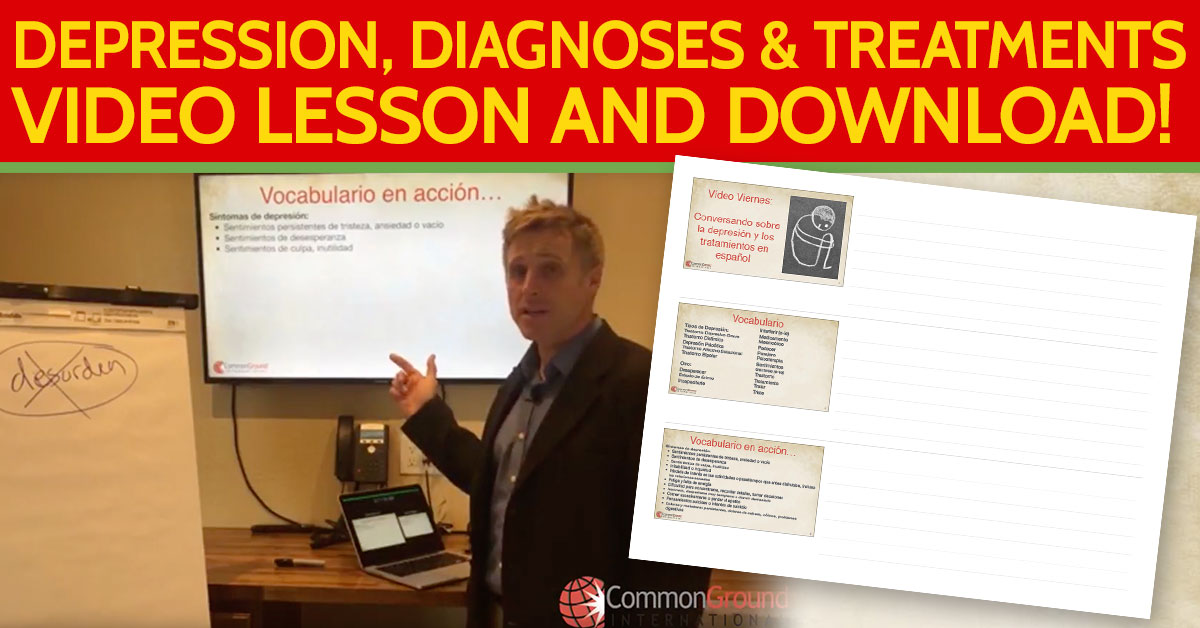This Medical Spanish lesson focuses on explaining the depression diagnoses and treatments in Spanish to your Spanish speaking patients.
Here is the Depression Diagnoses & Treatments in Spanish lesson I taught to the Facebook group:

Subscribe to our YouTube Channel to see all of our lessons and get the latest videos right away!
When we think back at the events of the last month, we know there are millions of people trying to put their lives together after hurricanes and tropical storms, and also the horrible events that people went through this past week in Las Vegas, we think about hope being the one thing that pulls people through and pushes them forward as they get through difficult times.
When you are working with patients that are dealing with uncertainty in life, in their own health situations or in their family situation here in the US, and you are able to meet with them and connect with them in Spanish you give peace and spread hope. Thank you for doing that!
Vocabulario
Tipos de depresión
| Trastorno Depresivo Grave | Severe Depressive Disorder |
| Trastorno Distímico | Dysthymic disorder |
| Depresión Psicótica | Psychotic Depression |
| Trastorno Afectivo Estacional | Seasonal Affective Disorder |
| Trastorno Bipolar | Bipolar Disorder |
Otro vocabulario
Vocabulario en acción
Síntomas de depresión – Symptoms of depression
| Sentimientos persistentes de tristeza, ansiedad o vacío | Persistent feelings of sadness, anxiety or emptiness |
| Sentimientos de desesperanza | Feelings of hopelessness |
| Sentimientos de culpa, inutilidad | Feelings of guilt, uselessness |
| Irritabilidad o inquietud | Irritability or restlessness |
| Pérdida de interés en las actividades o pasatiempos que antes disfrutaba, incluso las relaciones sexuales | Loss of interest in activities or hobbies that you once enjoyed, including sexual intercourse |
| Fatiga y falta de energía | Fatigue and lack of energy |
| Dificultad para concentrarse, recordar detalles, tomar decisiones | Difficulty concentrating, remembering details, making decisions |
| Insomnio, despertarse muy temprano o dormir demasiado | Insomnia, waking up too early or sleeping too much |
| Comer excesivamente o perder el apetito | Excessive eating or loss of appetite |
| Pensamientos suicidas o intentos de suicidio | Suicidal thoughts or suicide attempts |
| Dolores y malestares persistentes, dolores de cabeza, cólicos, problemas digestivos | Persistent pain and discomfort, headaches, cramps, digestive problems |
Diagnosis
Trastorno Depresivo Grave – Serious Depressive Disorder
- Una combinación de síntomas que interfieren con su capacidad para trabajar, dormir, estudiar, comer, disfrutar actividades
- Le incapacita a uno
- Puede ocurrir solo una vez en la vida, pero normalmente recurre durante toda la vida
| Combinación de síntomas | Combination of symptoms |
| Capacidad para ______ | Ability to ______ |
| Le incapacita | It incapacitates you |
| Ocurrir | Occur |
| Recurrir (Recurre) | Recur (It recurs) |
Trastorno Distímico – Dysthymic Disorder
- Síntomas depresivos de larga duración (años) pero menos graves que la depresión grave.
- No le incapacitan a uno, pero impiden la vida normal – uno no se siente bien
| Síntomas depresivos | Depressive symptoms |
| Larga duración | Long duration |
| Impedir (impiden) | Impede (They impede) |
Depresión Psicótica – Psychotic Depression
- Cuando depresión grave está acompañada con una forma de psicosis: ruptura con la realidad, alucinaciones, o delirios
Trastorno Bipolar – Bipolar Disorder
- Cambios cíclicos que alternan entre estados de ánimo muy elevados (manía) y estados de ánimo muy bajos (depresión).
Depresión Posparto – Postpartum Depression
- Un episodio de depresión grave en la mamá en el primer mes después de dar a luz a su bebé
- Cambios de estado de ánimo en mujeres después de dar a luz son normales por las hormonas, nuevas responsabilidades y cambios físicos – pero depresión posparto es más grave que la melancolía posparto
Trastorno Afectivo Estacional – Seasonal Affective Disorder
- Depresión que principalmente aparece durante los meses de invierno cuando hay menos sol y los días son más cortos. Normalmente los síntomas desaparecen en la primavera y verano.
Tratamientos – Treatments
Medicamentos – Los antidepresivos:
Apuntes – Notes
Es muy importante tomar los medicamentos cómo están indicados. Cuando empieza un medicamento nuevo, es normal tardar hasta 3-4 semanas para experimentar los efectos del medicamento.
| Medicamento nuevo | New medicine |
| Experimentar los efectos del medicamento | Experience the effects of the medication |
Terapias – Therapies
Dos tipos principales de psicoterapia:
- De corto plazo (10-20 semanas)
- De largo plazo (más tiempo).
Terapia cognitivo-conductal – Cognitive-behavioral Therapy:
- Hay una énfasis en enseñar nuevas maneras de pensar y comportarse.
- Ayuda a las personas cambiar sus pensamientos y comportamientos negativos por un estilo de pensar y portarse más positivo
Terapia interpersonal – Interpersonal Therapy:
- Ayuda a las personas entender y resolver relaciones personales que pueden causar o empeorar su depresión
Tratamientos Complementarios (estilo de vida) – Complementary Treatments (Lifestyle)
Rutinas y Actividades – Routines and Activities
| Practique actividades o ejercicios físicos moderados | Practice moderate physical activities or exercises |
| Haga las cosas que solía disfrutar | Do the things you used to enjoy |
| Participe en actividades religiosas y sociales en las que tenga una comunidad | Participate in religious and social activities where you have a community |
Dieta y Hábitos – Diet and Habits
| Comidas altas en Omega 3 (pescado, yogur, ensaladas) | Foods high in Omega 3 (Fish, yoghurt, salads) |
| Comidas altas en Vitamina B (vegetales de hoja verde, huevos y legumbres) | Foods high in Vitamin B (green leafy vegetables, eggs and legumes) |
| Carbohidratos complejos (granos integrales) | Complex carbohydrates (whole grains) |
| Evite bebidas alcohólicas | Avoid alcoholic beverages |
Now it’s your turn! I packaged all of this vocabulary in Spanish into some flashcards for you to study.
I packaged all of this into easily downloadable .pdf notes– Get your copy for free today!
Keep up the good work speaking responsible Spanish to your patients! Check out our other books, classes & products to help you !
*If the link isn’t working for you, you may need to unblock pop-ups in your browser settings.
[button link=”https://commongroundinternational.com/medical-spanish/screening-your-spanish-speaking-patients-for-depression/” style=”download” color=”green”]Related Lesson: Screening Your Spanish Speaking Patients for Depression[/button]
Other posts in this Mental Health series:
How to Evaluate Depression in Spanish using SIG E CAPS
This Medical Spanish lesson teaches you how to evaluate depression in Spanish using SIG E…
Questions and Phrases to Assess Child Abuse and Neglect in Spanish
This Medical Spanish lesson focuses on learning how assess child abuse and neglect in Spanish….
Mental health Conversation in Spanish – Listening Comprehension
Work on your listening comprehension in Spanish and learn about the mental health situation in…
How to Teach Coping Strategies in Spanish
Coping strategies in Spanish are “Estrategias de afrontamiento”. This week, as I was preparing to…
PHQ 9 and GAD 7 for depression and anxiety screenings in Spanish
Screening for depression and anxiety with the PHQ-9 and GAD-7 in Spanish. Do you ever…
Discussing ADD and ADHD in Spanish
ADD in Spanish is “TDA: el trastorno de déficit de atención” and ADHD is “TDAH:…
Discussing PTSD in Spanish
PTSD in Spanish PTSD is lesson 4 in our 5-lesson series on discussing mental health…
Discussing Substance Abuse in Spanish
In today’s lesson, we’re addressing topic #3 from the mental health survey that our community…
Discussing Anxiety in Spanish
This is Lesson 2 of 5 in our Mental Health in Spanish series. In this…
Discussing Depression in Spanish
This is Lesson 1 of 5 in our Mental Health in Spanish series. In this…
Mental Health Conversations in Spanish
In this free Medical Spanish lesson you will learn how to have Mental Health Conversations…















Pingback: Video Viernes - How to Evaluate Depression in Spanish using SIG E CAPS | Common Ground International Language Services
Pingback: Video Viernes - Knee Pain in Spanish: Symptoms, Exam, and Diagnosis | Common Ground International Language Services
Pingback: Video Viernes - Special uses of ESTAR in Spanish (Verb To Be) | Common Ground International Language Services
Pingback: Video Viernes - Explaining Prenatal Care in Spanish | Common Ground International Language Services
Pingback: Video Viernes Medical Spanish - Ser vs Estar (Verb To Be) in Spanish | Common Ground International Language Services
Pingback: Video Viernes - How to talk through the Labor & Delivery process in Spanish | Common Ground International Language Services